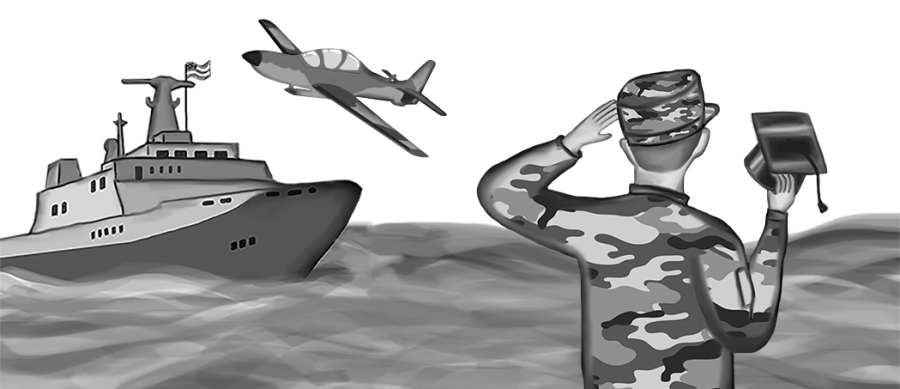As a kid, Daniel Katz ’09 dreamed of flying. He went to airshows in the southern California area whenever possible, where he was captivated by the fighter jets soaring through the open sky.
“I always wanted to be a fighter pilot, but like most childhood dreams, that just kind of faded as I got older,” Katz said. “I was still interested in flying jets but figured I would just have to put that on my bucket list for when I got older.”
During the summer before his junior year, Katz realized that his childhood dream could become a reality. He decided to look into the United States Air Force Academy, compelled by the idea of becoming a pilot while also receiving a quality education. He visited the academy’s Colorado campus and “fell in love,” prompting him to apply to and eventually attend the academy.
As a recent Air Force Academy graduate, Katz said he found the leadership training at the academy to be particularly valuable.
“From day one, you’re put in charge of people and held to a standard no other college kids are held to,” Katz said. “While challenging, it was extremely rewarding.”
While most students go on to attend either four-year liberal arts colleges or research universities after graduation, a select few choose to attend one-year, national service specialty institutions. Throughout the past five years, 10 students from the school have opted to take this route and apply to armed forces preparation academies.
“I wanted to do something that was meaningful and something that was going to teach me to become a better person,” Nina Avalos-Juarez ’16, who currently attends the Naval Academy Preparatory School in Rhode Island, said. “I always knew I wasn’t going to go to a regular four-year college and do the same old thing because I’m just not that person.”
Juarez participates in the Foundation Program that the school offers, which helps students transition mentally and physically, before moving on to the United States Naval Academy in Maryland.
“We do not have a lot of students drawn to these schools in any given year, but those that are tend to have a strong interest in serving their country and appreciate the structure of these academies,” Upper School Deans Department Head Beth Slattery said.
Programs, such as the one Juarez is enrolled in, offer free education in return for eventual service in the armed forces. Although the academies often have STEM-centered core curriculums that include courses in chemistry, physics and calculus, students are able to take electives as well. For example, Juarez is also studying music, data structures and algorithms.
“From my perspective, the primary benefit is free, top-notch education and the opportunity to be surrounded by other students with a common desire to serve,” Slattery said. “For the right students, who understand what their responsibilities are once they get there and after they graduate, the academics can be a great fit.”
Gabe Golob ’16 is also attending the Naval Academy Preparatory School. He initially committed to play Division One baseball. He said that there is a good balance between military and academic focus.
“[There is] military training – just marching to meals and everywhere we go,” Golob said. “Fridays, we have [physical therapy] in the morning and a brief of some sort in the afternoon. The physical part, in my opinion, is the easy part. As a recruited athlete, it’s why I’m here and what I enjoy the most.”
Golob said that while the transition into the academy was difficult, he felt supported by his peers.
“The three-week indoc[trination] to the navy was for sure a culture shock coming from Harvard-Westlake,” Golob said.
To be eligible for the USAFA, students must be between 17 and 23 years old. They must also be unmarried US citizens. There is a pre-candidate questionnaire, which opens to applicants March 1 of their junior year.
Students also must be nominated by a legally authorized entity in one of the following categories: congressional, vice presidential, military affiliated, U.S. Territory or international. Students are encouraged to request a nomination from both their U.S. Senator and their U.S. Representative and must be legal residents of the state from which they seek recommendation. Without an official nomination, the student cannot be accepted or considered for the Academy.
The Academy also examines the students’ academic performance, extracurricular activities and character. The character assessment entails an interview, a teacher evaluation, a personal statement and a drug and alcohol abuse certificate. There is also a fitness assessment, which tests the applicant’s ability to throw a basketball, do pull-ups, shuttle run, do crunches/sit-ups, do push-ups and run one mile. There are minimum performance levels that must be met for each of these activities, which can be found on the Academy’s official website.
Similarly, at the Naval Preparatory Academy School, students must first complete a preliminary application prior to being considered an official applicant. They then receive an official nomination and complete a second official candidate status application. Fitness and character assessments are also required.
Dean coordinator and Summer School Coordinator Camille da Santos said that the deans encourage students to apply to schools focused on preparation for the Army, Navy and Air Force if they desire a more rigid and rigorous curriculums than many other schools offer.
“The days are extremely rewarding, and at the end of the day, I go to bed knowing that I got better in some aspect of life,” Golob said. “I love that.”




































